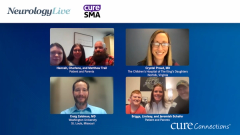
Advice for Community Neurologists When Dealing with SMA in Children
Families with patients with SMA share advice for community neurologists on helping new patients through the diagnostic process.
Episodes in this series

Crystal Proud, MD: Let’s go to Briggs and his parents. What advice would you have for a community neurologist in assessing kids who might show up in their office with symptoms similar to what Briggs was experiencing as you all were starting on this journey?
Lindsay: There were a lot of big, scary words. When they said, “We’re going to test for SMA [spinal muscular atrophy], but don’t look it up,” guess what I did. I don’t know if I have any advice for the community neurologist. It was a scary space to be in until we found out, and it was about 25 days until we found out. Each family deals with things differently. It’s emotional. It’s physical. It’s survival mode.
Jeremiah: [I don’t know if I have any advice] other than getting educated and getting the word out. It’s obviously huge to find out sooner—the earlier, the better—so you can start getting treatment.
Lindsay: And also maybe thinking outside the box, along with chiropractors and podiatrists. In our journey, it was never a medical problem. It was always flatfoot. For a physical therapist and a chiropractor to say, “Something isn’t right here,” they thought outside the box. It saved him. Who knows [where we’d be].
Crystal Proud, MD: What I’m hearing from you is that we need to provide more education to our community as well, because we need our podiatrists, chiropractors, physical therapists, occupational therapists, early intervention workers—anyone who plays any role in the care of patients—to be aware that there are conditions that involve muscles and nerves. [We need them to know] that there are specialists who take care of patients with muscle and nerve issues, and that there are therapies and treatments for some of these muscle and nerve conditions. If we don’t expand the awareness, then it may take somebody that longer journey before they get to diagnosis confirmation. There’s much more education that we need to do.
Craig Zaidman, MD: I want to add something, Dr Proud. You have to trust your parental instincts. Both groups of parents here had to go back over and over again. In Hannah’s case, it wasn’t as many times as most of the families I’ve seen. Usually, the mom and dad know something is wrong before the doctor knows something is wrong. Lindsay, you’re right that it takes thinking outside the box, but what you did is you kept seeking medical care, and then when that wasn’t right, you sought more medical care. It takes a lot of confidence to keep bringing your kid back when the doctor says, ”I think there’s nothing wrong here.” You start to doubt yourself. You’ve got to trust your instincts as a parent and you have to speak up and put your foot down about expressing yourself so that the person who’s seeing you understands how concerned you are.
Crystal Proud, MD: That’s meaningful as a pediatrician when the mom and dad say, “There’s something that doesn’t sit right. There’s something that doesn’t feel right.” We should listen to that and investigate that. Charlene and Matthew, what advice would you have for the community neurologist? They might not be as familiar with SMA.
Charlene: We didn’t have a horrible experience. My pediatrician listened to what I had to say, and after 2 or 3 visits, she said, “OK, I understand. Here’s what we’re going to do.” [The most important things are] knowledge, education, and for the doctors to listen.
Matthew: The biggest thing would be, the one thing they tell you is…
Charlene: And not look on the internet.
Matthew: Yes. The one thing they say is, “Don’t Google it.” Because when you Google it, it’s the scariest thing ever.
Charlene: It’s the first thing we did.
Matthew: It’s the very first thing we did. We got home and started Googling and I thought it was the end of our world. But instead of having Google, if they were able to give out the Cure SMA page or the MDA [Muscular Dystrophy Association] page or the resources where you can go and find actual…
Charlene: Good information.
Matthew: Good information instead of, “This is what’s going to happen.” Because if we had experienced that, then we wouldn’t be in this conversation right now. The information that comes from the doctor about stuff like that would be the best information that we could get.
Crystal Proud, MD: You’re saying to us to make sure that we provide you with the right resources. We can’t just say, “Don’t Google.” We have to say, “Here’s where to go.”
Matthew: Yes. “Don’t Google it. Go look here. Use this information.”
Charlene: “Use this resource.”
Matthew: WebMD isn’t the place to go.
Hannah: “Use this reliable resource.”
Matthew: Yes.
Crystal Proud, MD: I like that term, Hannah. It’s so true. We should familiarize ourselves with those resources. Dr Zaidman and I are both very grateful that the information on those resources is evolving, because we’re in a state of change with this diagnosis. We have therapies, interventions, and clinical trials. We have an incredible amount of hope. I’m pleased that the information that we have to share with newly diagnosed families may eventually be a little or even a lot different than each of your experiences as time goes forward.
I want to thank you all for watching this NeurologyLive® Cure Connections®. If you enjoyed the program, please subscribe for our e-newsletters to receive upcoming programs and other great content right in your inbox.
Transcript edited for clarity.
Newsletter
Keep your finger on the pulse of neurology—subscribe to NeurologyLive for expert interviews, new data, and breakthrough treatment updates.





















